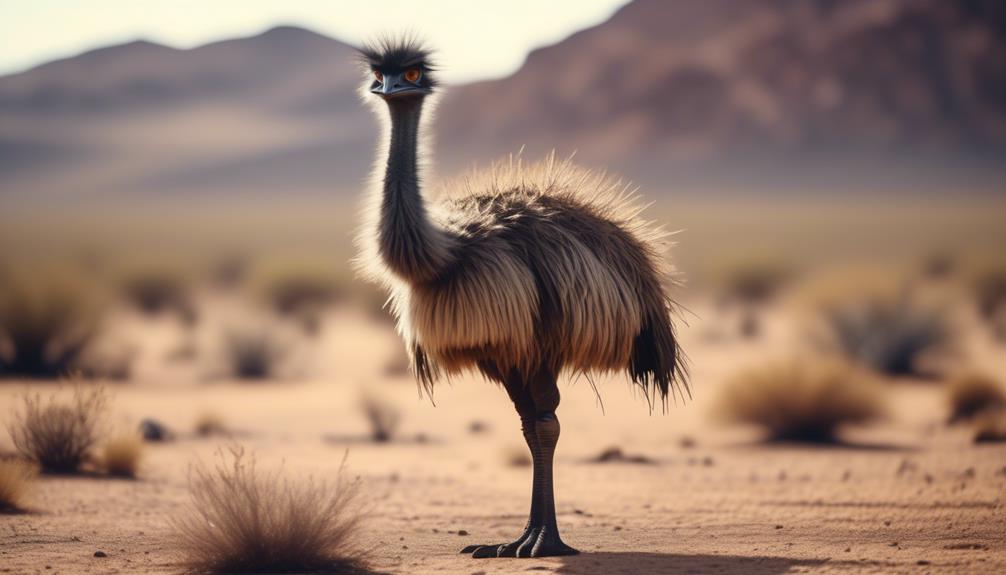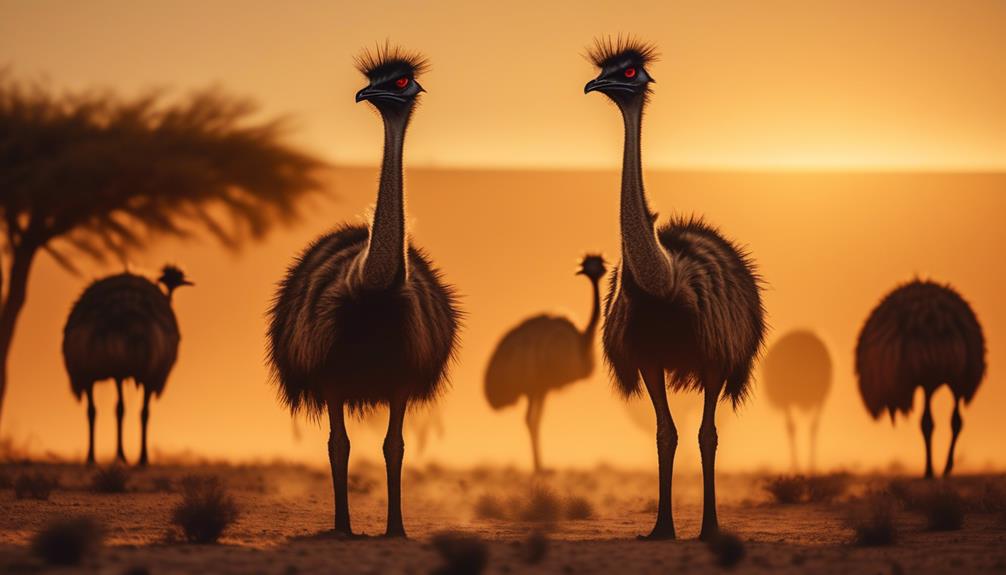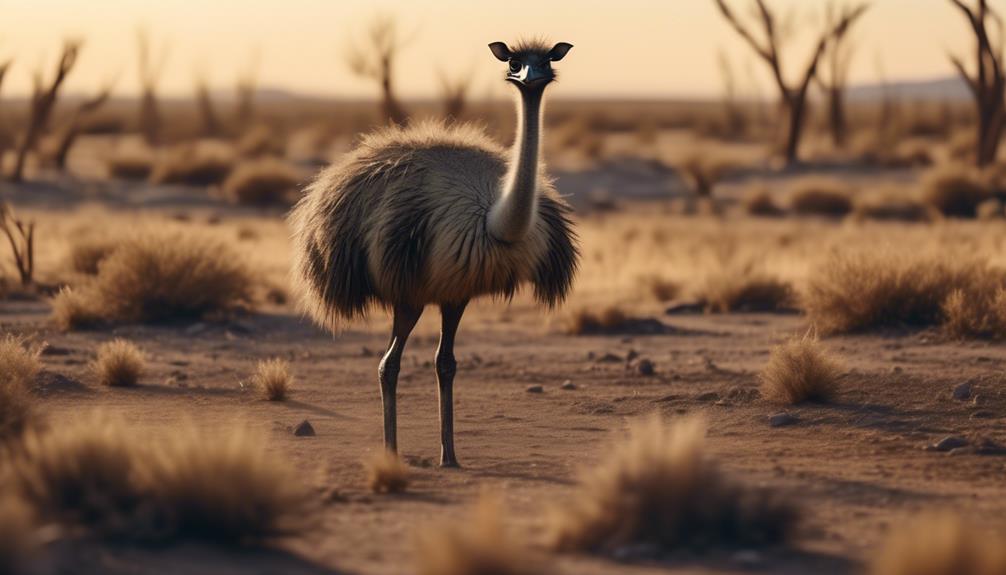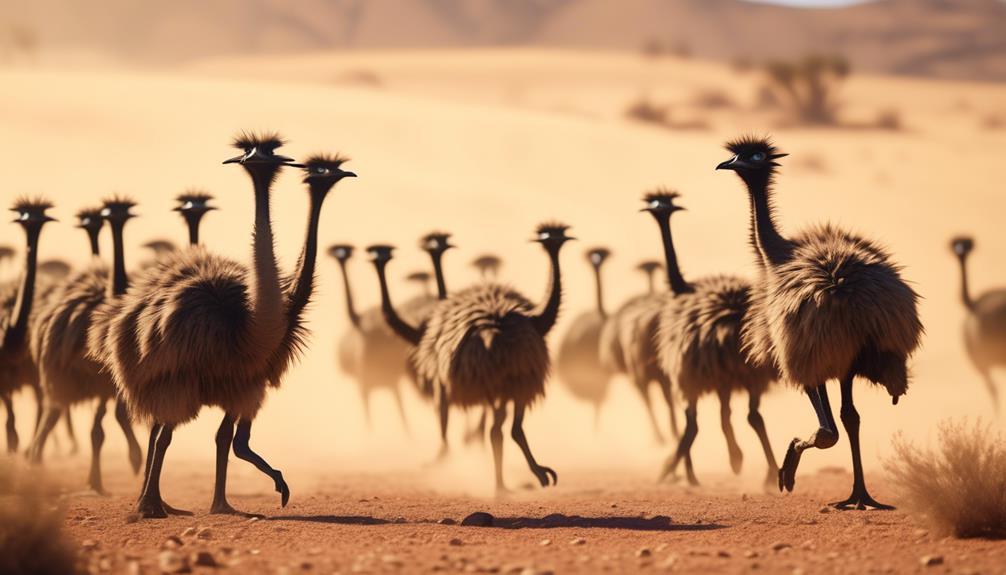
You may think that climate change only affects polar bears or coral reefs, but have you ever considered how it impacts emus and their habitat?
These iconic birds, native to Australia, are facing numerous challenges as our planet warms. Rising temperatures, altered weather patterns, and shifts in food availability are just a few of the ways climate change is impacting emus.
But what does this mean for their survival? And what efforts are being made to protect them?
In this discussion, we will explore the intricate relationship between climate change and emus, shedding light on the potential consequences and the conservation measures in place to ensure their future.
Emus: An Overview of Australia's Largest Birds

Emus, the largest birds in Australia, play a significant role in the country's unique ecosystem. These fascinating creatures have captured the hearts of many, leading to some individuals keeping them as pets. Emus as pets have gained popularity due to their docile nature and low maintenance requirements. They can provide companionship and serve as a unique addition to a household. However, it's crucial to note that emus aren't suitable for everyone, as they require a specific environment and proper care.
Emu feathers, known for their softness and durability, have been utilized for various purposes throughout history. These feathers have been used in traditional indigenous ceremonies, as well as in the creation of decorative crafts and jewelry. Emu feathers are also sought after in the fashion industry, where they're used in the production of hats, clothing, and accessories. Due to their insulating properties, emu feathers are highly valued in the creation of bedding and pillows, providing warmth and comfort.
Emu Habitat: Importance and Vulnerability
The habitat of emus holds significant importance in maintaining the ecological balance and biodiversity of Australia, making it crucial to understand its vulnerability to climate change. Emu conservation and the resilience of the ecosystem are at stake, as climate change alters the landscape and disrupts the delicate balance that emus rely on for survival.
To better grasp the vulnerability of emu habitat, let's take a closer look at the factors that make it susceptible to climate change:
| Habitat Factors | Vulnerability to Climate Change |
|---|---|
| Availability of Food | Changes in temperature and rainfall patterns can affect the growth and distribution of plants, impacting the emus' food sources. |
| Water Availability | Droughts and changes in precipitation can lead to water scarcity, making it challenging for emus to find sufficient water sources. |
| Vegetation Cover | Altered climate conditions can impact the density and composition of vegetation, potentially reducing suitable habitats for emus. |
| Breeding Grounds | Shifts in temperature and rainfall patterns can affect the timing and availability of suitable breeding grounds, impacting emu reproduction rates. |
Understanding these vulnerabilities is crucial for implementing effective conservation measures. By safeguarding the emu habitat and promoting ecosystem resilience, we can help ensure the long-term survival of these magnificent birds and maintain the delicate balance of Australia's biodiversity.
Rising Temperatures: Impact on Emu Survival

As the climate continues to change, the rising temperatures pose a significant threat to the survival of emus and their habitat in Australia. The impact on emu behavior can be quite profound, as these birds are well-adapted to specific temperature ranges. Emus are known for their ability to withstand hot and dry conditions, but the increasing temperatures are pushing them to their limits.
One of the long-term effects of rising temperatures is the scarcity of food and water sources for emus. As the temperature rises, the availability of vegetation decreases, leading to a decrease in the emus' primary food source. This scarcity not only affects the emus directly but also has a ripple effect on the entire ecosystem, as emus play a crucial role in seed dispersal. Without adequate food sources, emus will struggle to survive and reproduce, resulting in a decline in their population.
Additionally, the rising temperatures can also impact the reproductive behavior of emus. Emus rely on specific environmental cues, such as temperature and rainfall patterns, to determine when to breed. With the changing climate, these cues may become disrupted, leading to a mismatch in breeding and nesting times. This mismatch can have significant implications for the survival of emu chicks, as they depend on favorable environmental conditions for their growth and development.
Altered Weather Patterns: Challenges for Emus
Altered weather patterns present significant challenges for emus, affecting their ability to adapt and thrive in their changing habitat. As the climate changes, emus are forced to alter their behavior in order to cope with the new weather patterns. Here are three key challenges they face:
- Unpredictable rainfall: Emus rely on consistent patterns of rainfall to find water sources and maintain their hydration levels. However, altered weather patterns disrupt these patterns, leading to periods of drought followed by heavy rainfall. This inconsistency makes it difficult for emus to find reliable water sources, putting their survival at risk.
- Extreme temperatures: Climate change has led to an increase in temperature extremes, with heatwaves becoming more frequent and intense. Emus are adapted to withstand hot conditions, but prolonged exposure to extreme heat can be detrimental to their health. It can lead to dehydration, heat stress, and even death, especially for emus that are unable to find shade or water.
- Habitat loss: Altered weather patterns also contribute to habitat loss for emus. Increased rainfall can lead to flooding, destroying their nesting sites and food sources. On the other hand, prolonged droughts can cause vegetation to wither, reducing the availability of food and shelter. These changes in habitat availability and quality directly contribute to population decline among emus.
Food Availability: Consequences of Climate Change

Emus' ability to find and access food is significantly impacted by climate change, posing serious consequences for their survival and population dynamics. As the climate changes, it alters weather patterns and leads to shifts in the availability of food sources for these magnificent birds. Climate change-induced food scarcity affects not only the emus but also the entire ecosystem they inhabit.
Here is a table that illustrates the consequences of climate change on food availability for emus:
| Climate Change Consequences on Food Availability for Emus | Implications for Emus |
|---|---|
| Reduced rainfall and increased droughts | Limited water sources |
| Changes in vegetation patterns | Decreased food variety |
| Altered migration patterns | Disrupted feeding habits |
| Increased incidence of wildfires | Destroyed foraging areas |
| Decline in insect populations | Reduced food sources |
These consequences have far-reaching effects on emus' survival and population dynamics. With limited water sources and decreased food variety, emus struggle to find enough sustenance to survive. Disrupted feeding habits due to altered migration patterns further exacerbate their struggle. Additionally, the destruction of foraging areas from wildfires and the decline in insect populations further contribute to the scarcity of food resources for emus.
The consequences of climate change on emus' food availability are alarming. Urgent action is needed to mitigate the effects of climate change and ensure the long-term survival of these iconic birds.
Breeding and Nesting: Disruptions in Emu Reproduction
Breeding and nesting patterns of emus experience disruptions due to the effects of climate change on their habitat. These disruptions have significant implications for the reproductive success of emus.
Here are three key ways in which climate change impacts emu reproduction:
- Disrupted Breeding Seasons: Emus rely on specific environmental cues, such as temperature and rainfall patterns, to initiate breeding behaviors. However, climate change alters these cues, leading to irregular breeding seasons. Rising temperatures and unpredictable weather patterns can cause emus to delay or skip breeding altogether, resulting in reduced reproductive output.
- Nesting Failure: Emus construct large nests on the ground, where females lay their eggs and incubate them. However, climate change can disrupt this process. Extreme weather events, like heatwaves and heavy rainfall, can damage or destroy emu nests, leading to nesting failure. Additionally, changes in vegetation and habitat structure due to climate change can expose nests to predators, further increasing the risk of nesting failure.
- Reduced Chick Survival: Climate change impacts not only the breeding and nesting stages but also the survival of emu chicks. Changes in food availability, as discussed in the previous subtopic, can limit the resources necessary for chick growth and development. Additionally, extreme weather events, such as droughts or storms, can directly impact chick survival rates.
Migration Patterns: Emus on the Move

As emus navigate the challenges posed by climate change's impact on their breeding and nesting patterns, their migration patterns also undergo significant shifts. Climate change has led to changes in temperature and precipitation patterns, altering the availability of food sources and water bodies along the emus' migratory routes. These changes affect the timing and duration of their movements, as they seek more favorable conditions for survival.
Emus are known for their ability to travel long distances in search of food and suitable habitat. They typically migrate in response to seasonal changes, such as the availability of food and water. However, climate change disrupts these natural cues, causing emus to alter their migration patterns. In some cases, they may need to travel further to find suitable resources, while in other instances, they may need to change their routes entirely.
Research has shown that emus are adapting to climate change by altering the timing and duration of their migrations. For example, a study conducted in Australia found that emus are now migrating earlier in response to rising temperatures. By starting their migration earlier, emus can avoid the hottest parts of the day and reduce their risk of heat stress.
The impacts of climate change on emu migration patterns aren't limited to changes in timing and duration. Emus are also shifting their routes to access new food sources and water bodies. As certain areas become less favorable due to climate change, emus are exploring new territories and adapting their migration routes accordingly.
Understanding the effects of climate change on emu migration patterns is crucial for conservation efforts. By monitoring their movements and studying their response to changing environmental conditions, scientists can develop strategies to protect and preserve emu habitats. This includes identifying key areas for conservation and implementing measures to ensure the availability of food and water resources along their migratory routes.
Conservation Efforts: Protecting Emus and Their Habitat
Conservation efforts are essential for protecting the endangered emus and preserving their natural habitat in the face of climate change's impact. To ensure the survival of these magnificent birds and their ecosystem, various conservation strategies and habitat restoration initiatives have been implemented. Here are three key approaches that are being undertaken:
- Protected Areas: Establishing protected areas is crucial for safeguarding emus and their habitats. By designating specific areas as protected, these spaces can be managed and conserved to minimize the negative impacts of climate change. This includes regulating human activities, such as limiting development, managing invasive species, and implementing sustainable land use practices.
- Habitat Restoration: Restoring degraded habitats is vital for emus' survival. Restoration efforts involve rehabilitating ecosystems that have been damaged or altered due to climate change and other human-induced factors. This may include reforestation, reintroducing native plant species, and restoring natural water sources. By restoring the natural balance, emus can thrive in their original habitats.
- Research and Monitoring: Ongoing research and monitoring play a crucial role in understanding the effects of climate change on emus and their habitats. By studying their behaviors, migration patterns, and adaptations, scientists can develop effective strategies for conservation. Monitoring the population size and health of emus also helps in identifying potential threats and guiding conservation efforts.
Frequently Asked Questions
How Do Emus Contribute to the Ecosystem in Australia?
Emus contribute to the ecosystem in Australia by maintaining a balanced herbivore population, dispersing seeds through their droppings, and creating nesting sites for other birds. Their behavior plays a crucial role in shaping the biodiversity of their habitat.
What Are the Similarities and Differences Between Emu Habitats and Those of Other Bird Species?
Emu habitats have both similarities and differences compared to other bird species. Climate change impacts emu habitats, forcing them to adapt. Understanding these adaptations is crucial for preserving their habitat and ensuring their survival.
How Do Emus Adapt to Changing Weather Conditions in Their Habitat?
To adapt to changing weather conditions in their habitat, emus rely on their migration patterns and adjust their breeding behaviors according to the impact of extreme weather events.
Are There Any Specific Plants or Food Sources That Emus Rely On, and How Are They Affected by Climate Change?
Emu foraging patterns and diet are influenced by climate change impacts. Specific plants and food sources that emus rely on may be affected, altering their ability to find adequate nutrition in their changing habitat.
What Are Some Long-Term Solutions or Strategies Being Implemented to Ensure the Conservation of Emus and Their Habitat?
To ensure the conservation of emus and their habitat, long-term solutions and conservation strategies are being implemented. These efforts aim to protect the emus and their environment for future generations, promoting their survival and well-being.
Conclusion
In conclusion, climate change poses significant challenges to emus and their habitat.
One alarming statistic is that rising temperatures have already caused a 10% decline in emu populations over the past decade. This statistic evokes concern and highlights the urgent need for conservation efforts to protect these iconic birds and ensure their survival in the face of a changing climate.




